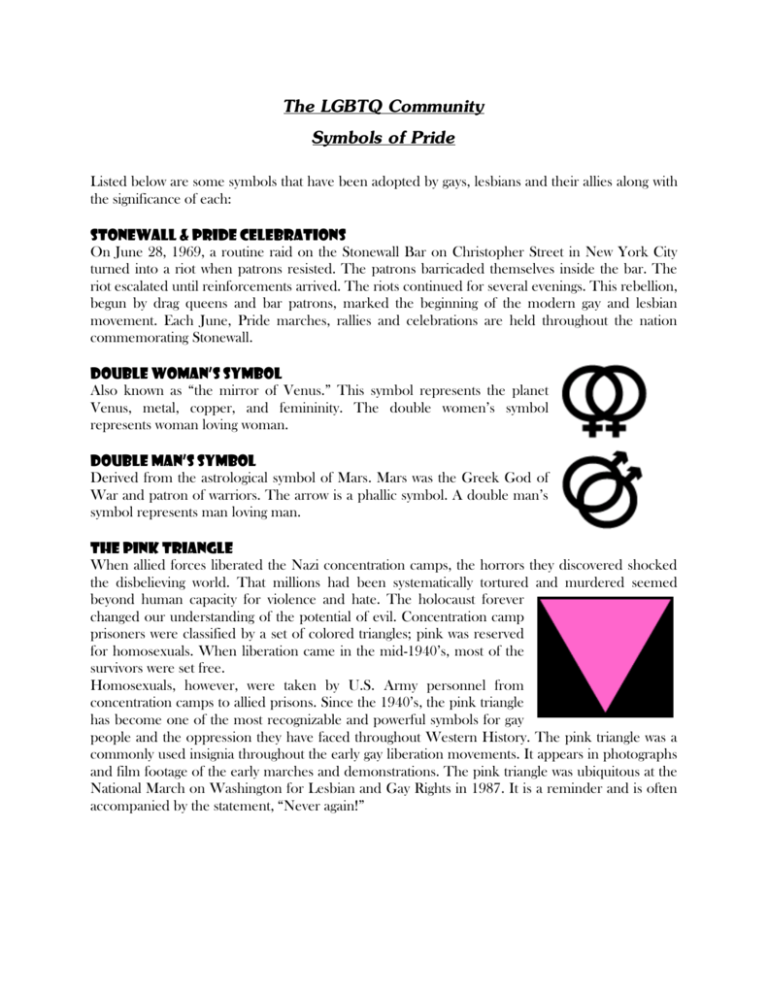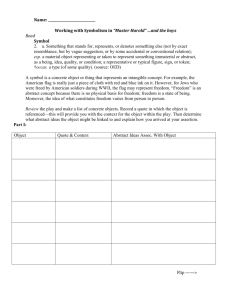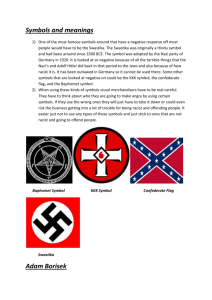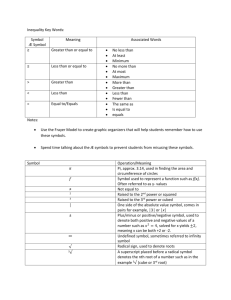The LGBTQ Community Symbols of Pride
advertisement

The LGBTQ Community Symbols of Pride Listed below are some symbols that have been adopted by gays, lesbians and their allies along with the significance of each: Stonewall & Pride Celebrations On June 28, 1969, a routine raid on the Stonewall Bar on Christopher Street in New York City turned into a riot when patrons resisted. The patrons barricaded themselves inside the bar. The riot escalated until reinforcements arrived. The riots continued for several evenings. This rebellion, begun by drag queens and bar patrons, marked the beginning of the modern gay and lesbian movement. Each June, Pride marches, rallies and celebrations are held throughout the nation commemorating Stonewall. Double Woman’s Symbol Also known as “the mirror of Venus.” This symbol represents the planet Venus, metal, copper, and femininity. The double women’s symbol represents woman loving woman. Double Man’s Symbol Derived from the astrological symbol of Mars. Mars was the Greek God of War and patron of warriors. The arrow is a phallic symbol. A double man’s symbol represents man loving man. The Pink Triangle When allied forces liberated the Nazi concentration camps, the horrors they discovered shocked the disbelieving world. That millions had been systematically tortured and murdered seemed beyond human capacity for violence and hate. The holocaust forever changed our understanding of the potential of evil. Concentration camp prisoners were classified by a set of colored triangles; pink was reserved for homosexuals. When liberation came in the mid-1940’s, most of the survivors were set free. Homosexuals, however, were taken by U.S. Army personnel from concentration camps to allied prisons. Since the 1940’s, the pink triangle has become one of the most recognizable and powerful symbols for gay people and the oppression they have faced throughout Western History. The pink triangle was a commonly used insignia throughout the early gay liberation movements. It appears in photographs and film footage of the early marches and demonstrations. The pink triangle was ubiquitous at the National March on Washington for Lesbian and Gay Rights in 1987. It is a reminder and is often accompanied by the statement, “Never again!” The Rainbow Flag The rainbow flag has been adopted by the gay and lesbian community as its own design. It depicts not the shape of the rainbow but its colors in horizontal stripes. Created in 1978 for San Francisco’s Gay Freedom Celebration by local artist, Gilbert Baker, it was inspired by the “Flag of the Races”, which had five stripes – one each for the colors of humankind’s skin, flown at the 1960 college campus demonstrations. Major gay and lesbian parades in New York, Houston, Vancouver and Toronto began to fly the six-stripe Rainbow Flag. It is prominently displayed at all homosexual events. In New York, the Rainbow Flag drapes coffins of people who have died of AIDS, and is frequently displayed on hospital doors. The AIDS ward of a Sydney, Australia hospital flies the Rainbow Flag as a symbol of hope. In a few short years, the flag has spread worldwide to represent a movement. Its success is not due to any official recognition but to the widespread spontaneous adoption by members of the community it represents. The Labrys The double-bladed axe comes from a myth as the scepter of the goddess Demeter (Artemis). It may have originally been used in battle by female Scythian warriors. The labrys appear in ancient Cretan art and has become a symbol of lesbianism. The Lambda Chosen by the Gay Activist Alliance in 1970 as the symbol of the gay movement, the lambda is the Greek letter “L”. A battle flag with the lambda carried by a regiment of ancient Greek warriors who were accompanied in battle by their young male lovers and noted for their fierceness and willingness to fight to the death. was Freedom Rings Designed by David Spada with the Rainbow Flag in mind, these six colored aluminum rings have come to symbolize independence and tolerance of others. The rings are frequently displayed or worn as jewelry and can be found as necklaces, bracelets, rings and key chains. Bisexuality Symbol(s) A common symbol of the Bisexual community is the bisexual pride flag, which has a deep pink stripe at the top for homosexuality, a blue one on the bottom for heterosexuality, and a purple one, blended from the pink and blue, in the middle to represent bisexuality. Another symbol that uses the color scheme of the bisexual pride flag is a pair of overlapping pink and blue triangles, the pink triangle being a well-known symbol for the homosexual community, forming purple where they intersect. Transgender symbol(s) Popular transgender symbols, used to identify transvestites, transsexuals, and other transgender people, frequently consist of modified gender symbols combining elements from both the male and female symbols. The most popular version, originating from a drawing by Holly Boswell, depicts a circle with an arrow projecting from the top-right, as per the male symbol, a cross projecting from the bottom, as per the female symbol, and with an additional strike arrow (combining the female cross and male arrow) projecting from the top-left. Another transgender symbol is the Transgender Pride flag designed by Monica Helms, and first shown at a pride parade in Phoenix, Arizona, USA in 2000. The flag represents the transgender community and consists of five horizontal stripes, two light blue, two pink, with a white stripe in the center. Other transgender symbols include the butterfly (symbolizing transformation or metamorphosis), and a pink/light blue yin and yang symbol. Pansexuality Symbol(s)








